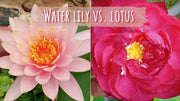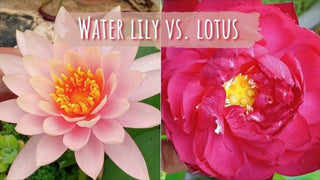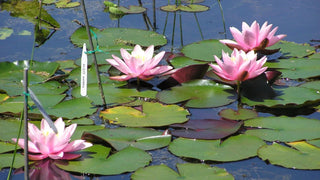
You spotted a graceful bloom online—huge petals framed by emerald disks—and fell in love. But was it a lotus or a water lily? Garden-center tags and social media posts often blur the line, leaving new pond keepers guessing. Choosing wrong can mean planting a majestic flower that towers 1 m above the surface when you really wanted something that floats like a dinner plate—or vice versa. In this deep dive we untangle the confusion between lotus vs water lily (and the flip side, water lily vs lotus), so you can pick the perfect centerpiece and support it with the right Poposoap gear for a thriving, low-maintenance pond.
Two Iconic Pond Flowers, One Common Confusion
Both lotus and water lilies have enchanted cultures for millennia, yet they belong to entirely different plant families. The confusion starts because casual articles call anything with a floating pad a “lotus.” Add translation quirks (the Chinese word lian can mean either), or you get mislabeled photos everywhere. This guide sticks to botanical reality, helping you decide whether a rising lotus or a sprawled carpet of lilies better suits your space—and showing where a Poposoap floating fountain or pond filter kit fits the plan.
Quick Comparison Table: At a Glance
| Trait | Lotus (Nelumbo nucifera / N. lutea) | Water Lily (Nymphaea spp.) |
|---|---|---|
| Leaf Position | Emergent leaves stand above water | Floating—leaves rest on surface |
| Flower Height | 15 – 100 cm above water | Usually on surface or just above |
| Leaf Texture | Waxy, water-repellent, round center | Flat, split to stem notch; water beads spread |
| Rooting Depth | 30 – 120 cm soil | 15 – 60 cm soil |
| Winter Hardiness | Tubers must not freeze solid | Hardy species overwinter below ice |
| Ideal Partners | Quiet water, Poposoap Pond Filters to reduce nutrients | Poposoap Floating Fountains add movement without uprooting |
One glance, and “lotus flower vs water lily” starts looking simply.
Botanical Background: Different Plants Entirely

Lotus belongs to Nelumbonaceae, a family closer to plant trees than lilies. They store energy in pepper-shaped tubers and breathe through aerial petioles. Water lilies sit in Nymphaeaceae, an ancient lineage of true aquatics—think floating rhizomes and pads laced with air channels. Mix-ups matter: lotus tubers want heavy loam, lilies prefer pea gravel; lotus can suffocate if water is too deep, lilies laugh at depth as long as light penetrates.
Poposoap’s brand mantra is “hassle-free water features that bring beauty and joy.” Knowing your plant’s family lets you pick the right substrate basket and circulation level—a perfect match for that no-stress ethos.
Flower & Leaf Differences (and Why Poposoap Surface Gear Matters)

Leaves—Lotus pads are matte green plates held on stalks that shrug off raindrops like Teflon. Water-lily pads lie flat, often marbled, catching beads that sparkle in sunlight.
Flowers—Lotus buds rocket upward, opening to 20 cm saucers that follow the sun. When petals fall, a distinctive shower-head seedpod remains. Lily blossoms float serenely, petal count varying by hybrid but always anchored close to leaves.
Because lotus leaves poke up like umbrellas, vigorous surface agitation can shred new shoots. That’s why Poposoap’s floating fountains—equipped with multiple nozzle heights—are ideal for lily zones but should be placed well away from lotus tubs. Gentle circulation around lilies oxygenates roots and shows off mirrored petals; still pockets around lotus keep statuesque stems intact.
Growth & Environmental Needs
Sunlight – Both crave minimum six hours of direct sun; lotus demand heat for tuber energy, lilies bloom sluggishly in shade.
Water Depth – Hardy lilies: 30 – 60 cm; dwarf tropical: 15 – 30 cm. Standard lotus: 45 – 90 cm, bowl lotus: 20 cm.
Nutrients – Lotus are heavy feeders, lilies moderate. Over-fertilizing either trigger algae outbreaks.
Here Poposoap Pond Filter Kits shine: coarse pre-screens block petal debris; layered foam and bio-rings strip dissolved nutrients so neither plant turns the pond into pea soup. Solar-powered options let you tuck the filter where cords won’t mar your landscape, aligning with the brand’s eco-friendly mission.
Pond Design: Which One Should You Plant?

Choose lotus when…
- You want a bold vertical accent—backyard equivalent of a pagoda.
- Your pond is at least 1 m wide; leaves can sprawl 60 cm each.
- You enjoy harvesting seed pods or tubers for culinary or craft use.
Choose water lilies when…
- Surface coverage and shade for fish are top priorities.
- You crave continuous bloom: hardy lilies flower May – September, tropicals even longer.
- You have limited depth; a 40 cm patio bowl can host dwarf lilies.
Many keepers use both: lilies carpet the deep end; lotus crown a marginal shelf. The trick is balancing nutrient uptake and making sure circulation patterns don’t uproot tubers—again, where Poposoap’s variable-flow pumps earn their keep.
Can You Plant Both Together?
Absolutely, with planning:
- Place lotus in a large planter at one end.
- Anchor lilies around mid-depth.
- Position a Poposoap Pond Filter Box close to lotus to capture heavy leaf fall. A second box near lilies absorbs petal litter—preventing “tea-colored” water without daily skimming.
Using two smaller filters instead of one oversized unit mirrors the company’s modular design philosophy and keeps maintenance trays lightweight.
Maintenance Tips for Each Plant

Lotus
- Repot every two years before shoots sprout.
- Insert slow-release fertilizer tabs monthly in summer.
- In cold zones, tubers sink to the deepest part or overwinter indoors.
Water Lilies
- Trim yellow leaves weekly; decaying pads spike ammonia.
- Divide rhizomes every 3–4 years to sustain bloom count.
- Thin pads to ⅔ surface coverage so Poposoap floating fountain jets stay effective.
Both benefit from clear water: the clearer the column, the richer the petal color. A Poposoap solar fountain circulated through its own mesh pre-filter keeps water polisher-clean while adding gentle oxygen to fish.
Cultural Symbolism (Why It Might Matter to You)
The lotus flower vs water lily debate is older than hobby ponds. Lotuses symbolize purity rising from mud in Buddhism and rebirth in Egypt. Water lilies represent tranquility in Western art and are the star of Monet’s canvases. If personal resonance matters to your garden narrative, let mythology steer your choice.
Conclusion: A Beautiful Choice Either Way
Whether you favor the lofty elegance of lotus or the graceful spread of water lilies, the right choice can turn a quiet pond into a living masterpiece. Keep these points in mind:
- Lotus rise, lilies carpet
- Lotus prefer stillness, lilies enjoy gentle movement
- Both thrive with balanced filtration
Combine either plant with Poposoap’s solar pond filters, floating fountains, LED lighting, and solar water pumps, and you’ll enjoy vibrant blooms all season—free of tangled cords and rampant algae. That’s the key to mastering water lilies versus lotus: breathtaking beauty, a healthy ecosystem, and zero fuss.
So, pick your flower—water lily vs lotus flower no longer a mystery—set the tuber or rhizome, and watch your pond transform into the garden oasis you imagined.







